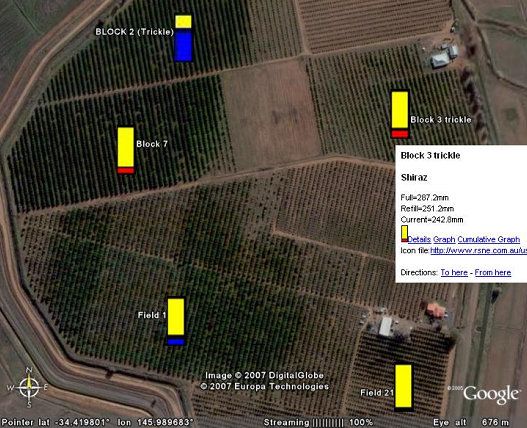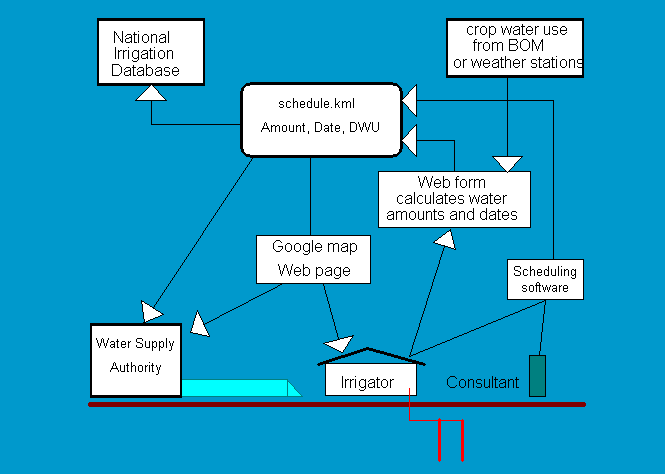National Irrigation Database
A National Irrigation Database could be created, using existing data, if there was an agreed, common, data format.
The database would show, for every field in Australia...
- How much water is required, and when.
- How much water was applied, and when.
- How much excess water was used.
Water Supply Authorities would now be able to calculate total water requirements in the next few weeks and for the remainder of the season.
They would also be able to see the current irrigation status of all their irrigators on a map.
A common file format using xml
The common format could be the xml schema developed by Google for GIS mapping.
XML is flexible - as well as GPS latitude and longitude, extra data can be carried by the Google xml files.
- Required_Volume (Ml)
- Required_Date
- Soil_Moisture (mm)
- Crop_Daily_Water_Use (mm/day)
- Season Total_Volume_Required (Ml)
- Crop_Type
The same XML file can be shared
From the same file...
A Water Supply Authority would see water orders like this...
| Irrigator | Required Volume Ml | Required Date |
|---|---|---|
| Paul Torzillo | 55 | 13 February 2006 |
| McWilliams | 32 | 12 February 2006 |
The National Irrigation Database would see this...
| FarmID | SiteID | Crop | Required Volume Ml | Required Date | Crop Daily Water Uuse mm/day |
|---|---|---|---|---|---|
| 7104 | 1 | Shiraz | 32.5 | 11 Feb 2007 | 3.6 |
| 7104 | 2 | Merlot | 41.0 | 23 Feb 2007 | 4.5 |
| 7104 | 3 | Olives | 22.5 | 13 Feb 2007 | 4.3 |
| 8207 | 7 | Olives | 19.5 | 25 Feb 2007 | 3.7 |
| 8207 | 21 | Prunes | 35.6 | 26 Feb 2007 | 3.5 |
Irrigators would see their schedule like this...

How it would work

Irrigators would enter their water requirements - the irrigation schedule - on a web form.
Crop water use from BOM could be used to calculate crop water requirements.
Alternatively, the shedule could be generated by irrigation scheduling software and uploaded to the web.
In return, the irrigator could see their current irrigation status on a map or aerial photograph, which could then be overlaid with other data such as yield maps or soil surveys.
Water Supply Authorities and the National Irrigation Database will also read the same file.
What needs to be done
- Web form for Irrigators to order water. The form can also be used to calculate and post irrigation schedule.
- Crop water use data to be available on the web from BOM in an agreed standard format.
- Water Supply Authorities to be able to read and accept water orders in the agreed xml schema.
- All irrigation scheduling software to output a schedule in the agreed xml schema..
- A national irrigation database could then be set up that would also read the xml files.
Download a Powerpoint (1.4 Mb) version or a Word DOC (1.4 Mb) version